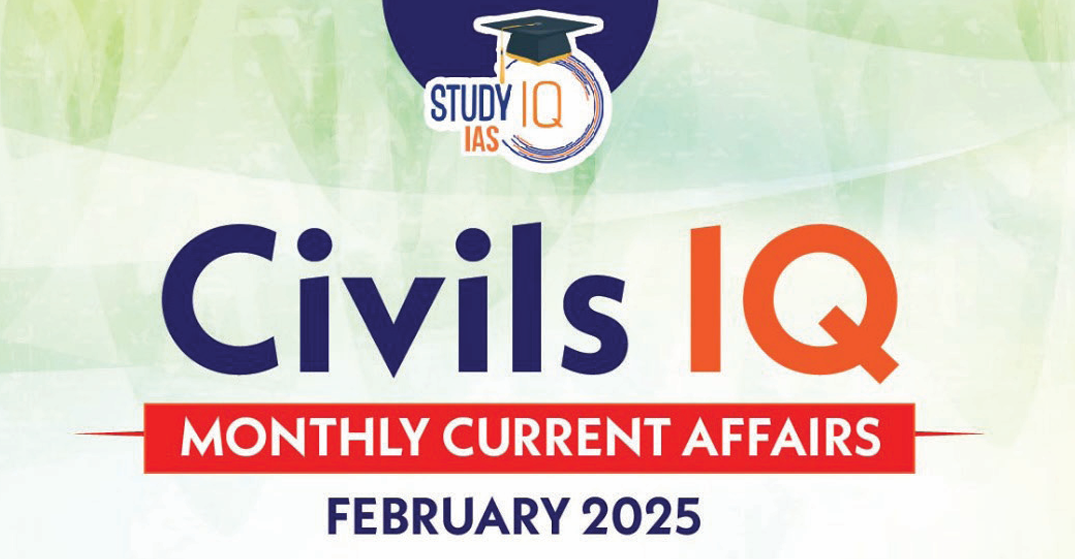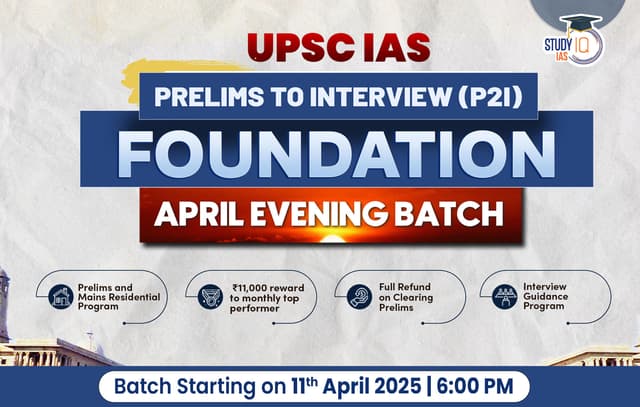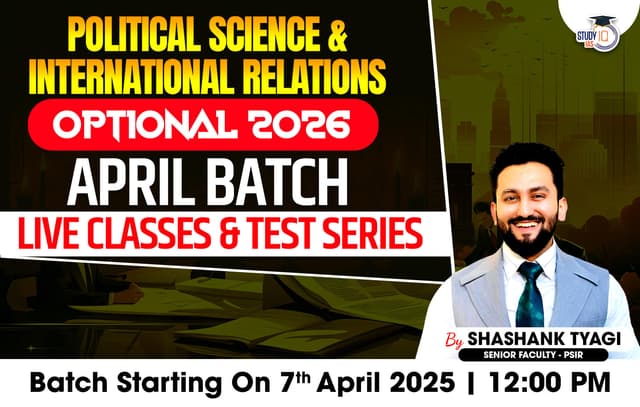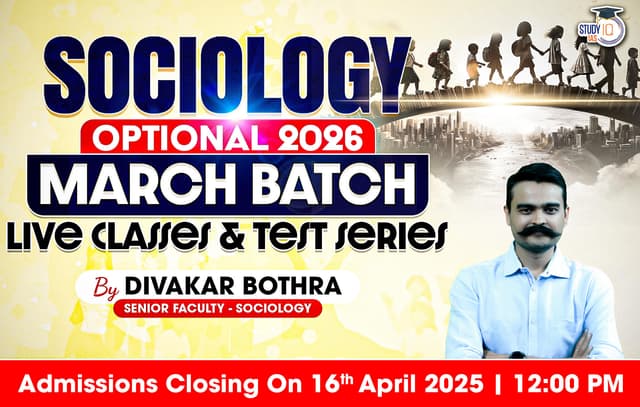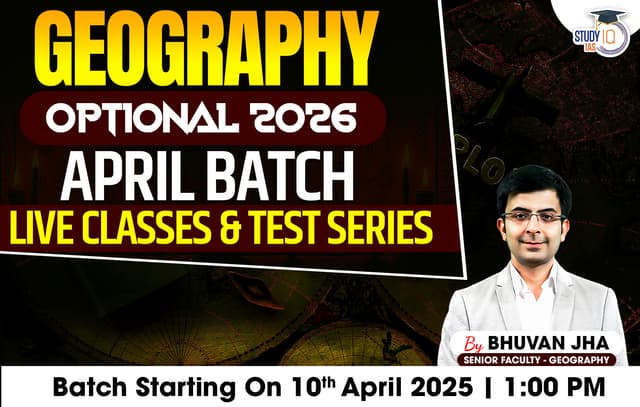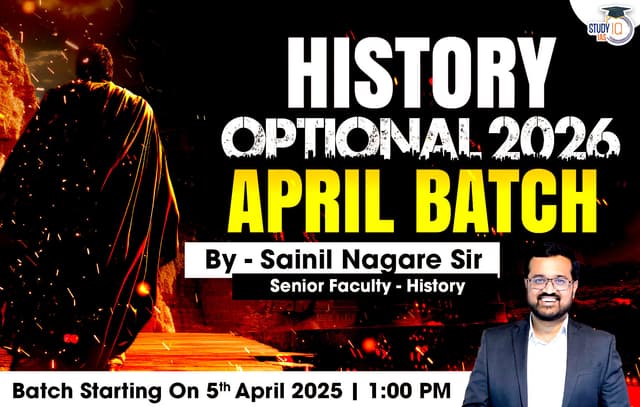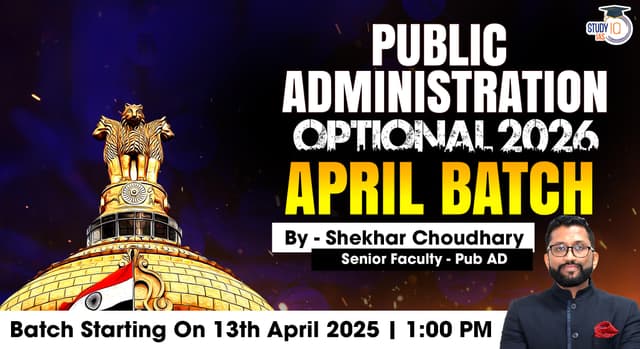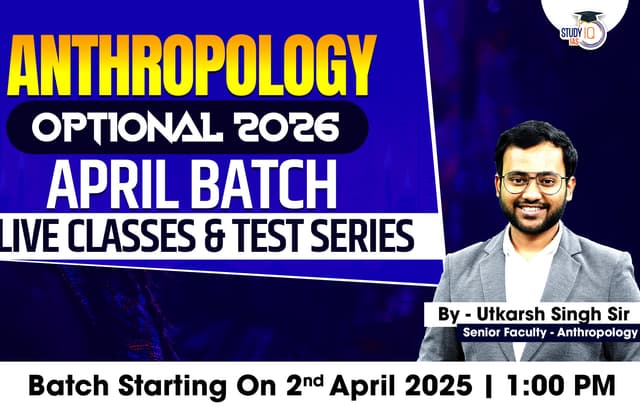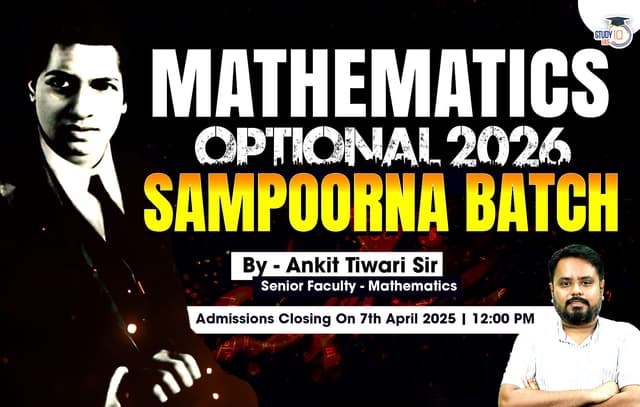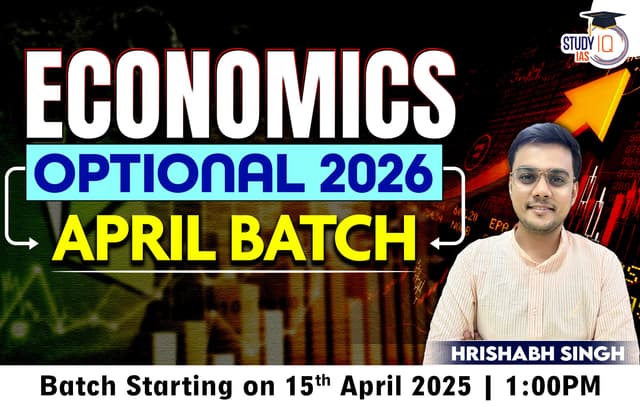Daily Quiz 07 March 2025
Quiz-summary
0 of 5 questions completed
Questions:
- 1
- 2
- 3
- 4
- 5
Information
- Click on – ‘Start Quiz’ button
- Solve Questions
- Click on ‘Next’ button
- Click on ‘Finish Quiz’ button
- Now click on ‘View Questions’ button – here you will see solutions and links.
- The test contains a total of 5 questions.
- Click on the most appropriate option to mark it as your answer.
- You will be awarded Two marks for each correct answer.
- You can change your answer by clicking on some other option.
- A Number list of all questions appears at the top side of the screen.
- You can access the questions in any order by clicking on the question number given on the number list.
- You can use rough sheets while taking the test.
- Do not use calculators, log tables, dictionaries, or any other printed/online reference material during the test.
- Do not click the button “Finish Quiz” before completing the test. A test once submitted cannot be resumed.
You have already completed the quiz before. Hence you can not start it again.
Quiz is loading...
You must sign in or sign up to start the quiz.
You have to finish following quiz, to start this quiz:
- 1
- 2
- 3
- 4
- 5
- Answered
- Review
-
Question 1 of 5
1. Question
1 pointsConsider the following statements with reference to Coalition for Disaster Resilient Infrastructure (CDRI):
- It was launched by India at the UN Climate Action Summit in 2019.
- It is not an intergovernmental organization.
- The CDRI Secretariat is based in New Delhi, India.
How many of the above statements are correct?
Correct
Answer: C
Explanation:
- The Coalition for Disaster Resilient Infrastructure (CDRI) is a multi-stakeholder global partnership of national governments, UN agencies and programmes, multilateral development banks and financing mechanisms, the private sector, and academic and knowledge institutions. It addresses the challenges of building resilience into infrastructure systems and development associated with it.
- Statement 1 is correct: The Prime Minister of India launched CDRI during his speech at the UN Climate Action Summit on 23 September 2019. The Prime Minister had initially announced India’s intention to work with partner countries and key stakeholders to form a coalition working towards the goal of improving the disaster resilience of infrastructure at the Asian Ministerial Conference on Disaster Risk Reduction (AMCDRR) held in November 2016 in New Delhi. Since the AMCDRR, the Government of India has advocated for the issue of DRI and organized a series of consultations, advocacy efforts, and preparatory work at various regional and international forums.
- Statement 2 is correct: CDRI is a multi-stakeholder global partnership of national governments, UN agencies and programmes, multilateral development banks and financing mechanisms, the private sector, and academic and knowledge institutions. At present, it is not an intergovernmental organization, which are ordinarily treaty-based organizations.
- Statement 3 is correct: The CDRI Secretariat is based in New Delhi, India.
Incorrect
Answer: C
Explanation:
- The Coalition for Disaster Resilient Infrastructure (CDRI) is a multi-stakeholder global partnership of national governments, UN agencies and programmes, multilateral development banks and financing mechanisms, the private sector, and academic and knowledge institutions. It addresses the challenges of building resilience into infrastructure systems and development associated with it.
- Statement 1 is correct: The Prime Minister of India launched CDRI during his speech at the UN Climate Action Summit on 23 September 2019. The Prime Minister had initially announced India’s intention to work with partner countries and key stakeholders to form a coalition working towards the goal of improving the disaster resilience of infrastructure at the Asian Ministerial Conference on Disaster Risk Reduction (AMCDRR) held in November 2016 in New Delhi. Since the AMCDRR, the Government of India has advocated for the issue of DRI and organized a series of consultations, advocacy efforts, and preparatory work at various regional and international forums.
- Statement 2 is correct: CDRI is a multi-stakeholder global partnership of national governments, UN agencies and programmes, multilateral development banks and financing mechanisms, the private sector, and academic and knowledge institutions. At present, it is not an intergovernmental organization, which are ordinarily treaty-based organizations.
- Statement 3 is correct: The CDRI Secretariat is based in New Delhi, India.
-
Question 2 of 5
2. Question
1 pointsHe was an Indian liberal political leader and a social reformer during the Indian Independence Movement. Apart from beinga senior leader of the Indian National Congress, he was the founder of the Servants of India Society. He was famously a mentor to Mahatma Gandhi in the latter’s formative years. This is the most likely description of:
Correct
Answer: B
Explanation:
- Option B is correct: Born on 9 May, 1866, in Maharashtra, Gopal Krishna Gokhale was an Indian liberal political leader and a social reformer during the Indian Independence Movement.
- Being one of the first generations of Indians to receive a university education, Gokhale graduated from Elphinstone College in 1884. In addition to learning English, he was exposed to Western political thought and became a great admirer of theorists such as John Stuart Mill and Edmund Burke. He had a great influence of the social works of Justice Mahadev Govind Ranade on his life. He was named as the Protege Son’ i.e. Manas Putra of Justice Mahadev Govind Ranade.
- Apart from beinga senior leader of the Indian National Congress, he was the founder of the Servants of India Society. Through the Society as well as the Congress and other legislative bodies he served in, Gokhale campaigned for Indian self-rule and for social reforms.
- Gokhale was famously a mentor to Mahatma Gandhi in the latter’s formative years. As a young barrister, Gandhi returned from his struggles against the Empire in South Africa and received personal guidance from Gokhale, including a knowledge and understanding of India and the issues confronting common Indians.
- Gokhale’s deposition before the Welby Commission on the financial condition of India won him accolades. His speeches on the budget in the Central Legislative Council were unique, with thorough statistical analysis. He played a leading role in bringing about Morley-Minto Reforms in India. He was a scholar and a statesman, arguably the greatest Indian liberal.
Incorrect
Answer: B
Explanation:
- Option B is correct: Born on 9 May, 1866, in Maharashtra, Gopal Krishna Gokhale was an Indian liberal political leader and a social reformer during the Indian Independence Movement.
- Being one of the first generations of Indians to receive a university education, Gokhale graduated from Elphinstone College in 1884. In addition to learning English, he was exposed to Western political thought and became a great admirer of theorists such as John Stuart Mill and Edmund Burke. He had a great influence of the social works of Justice Mahadev Govind Ranade on his life. He was named as the Protege Son’ i.e. Manas Putra of Justice Mahadev Govind Ranade.
- Apart from beinga senior leader of the Indian National Congress, he was the founder of the Servants of India Society. Through the Society as well as the Congress and other legislative bodies he served in, Gokhale campaigned for Indian self-rule and for social reforms.
- Gokhale was famously a mentor to Mahatma Gandhi in the latter’s formative years. As a young barrister, Gandhi returned from his struggles against the Empire in South Africa and received personal guidance from Gokhale, including a knowledge and understanding of India and the issues confronting common Indians.
- Gokhale’s deposition before the Welby Commission on the financial condition of India won him accolades. His speeches on the budget in the Central Legislative Council were unique, with thorough statistical analysis. He played a leading role in bringing about Morley-Minto Reforms in India. He was a scholar and a statesman, arguably the greatest Indian liberal.
-
Question 3 of 5
3. Question
1 pointsConsider the following statements:
1. Both ex-gratia payments and compensation are payments made out of legal obligation.
2. Neither ex-gratia payment nor compensation can be paid in cash.
Which of the statements given above is/are correct?
Correct
Answer: D
Explanation:
- Statement 1 is not correct: Ex-gratia payments are payments made out of moral not legal obligation. For instance, ex-gratia payment by the government after a tragedy, such as the one which occurred in New Delhi last Saturday, shows its goodwill, and does not involve admitting any liability or wrongdoing. Compensations, on the other hand, are made out of a legal obligation. They are reparatory payments made to reimburse or make amends for the loss of life, property, or livelihood, among other things.
- Statement 2 is not correct: While disbursal of ex-gratia payment in cash is not common, there are no strict government-issued guidelines on the mode of such disbursals.
- That said, in the case of train accidents, a 2023 communication by the Railway Board stipulated that a maximum amount of upto Rs. 50,000 is “to be paid in cash as an immediate relief for taking care of initial expenses” after rail accidents. “The remaining amount to be paid by Account Payee Cheque/RTGSNEFT/Any other online payment mode,” the communication stated.
While cash payments of entire ex-gratia amounts are “not usual”, “the exigency has to be seen and if it requires immediate ex-gratia payment”.
Incorrect
Answer: D
Explanation:
- Statement 1 is not correct: Ex-gratia payments are payments made out of moral not legal obligation. For instance, ex-gratia payment by the government after a tragedy, such as the one which occurred in New Delhi last Saturday, shows its goodwill, and does not involve admitting any liability or wrongdoing. Compensations, on the other hand, are made out of a legal obligation. They are reparatory payments made to reimburse or make amends for the loss of life, property, or livelihood, among other things.
- Statement 2 is not correct: While disbursal of ex-gratia payment in cash is not common, there are no strict government-issued guidelines on the mode of such disbursals.
- That said, in the case of train accidents, a 2023 communication by the Railway Board stipulated that a maximum amount of upto Rs. 50,000 is “to be paid in cash as an immediate relief for taking care of initial expenses” after rail accidents. “The remaining amount to be paid by Account Payee Cheque/RTGSNEFT/Any other online payment mode,” the communication stated.
While cash payments of entire ex-gratia amounts are “not usual”, “the exigency has to be seen and if it requires immediate ex-gratia payment”.
-
Question 4 of 5
4. Question
1 pointsWith reference to Gulf Cooperation Council, consider the following statements:
- It consists of all the countries from the Arabian peninsula.
- Its headquarters are located in Riyadh, Kingdom of Saudi Arabia.
- The Supreme Council is the highest authority of the GCC, composed of the heads of the member states, with its presidency rotating alphabetically.
How many of the above statements are correct?
Correct
Answer: B
Explanation:
- Statement 1 is not correct: The members of Gulf Cooperation Council (GCC) include:
- United Arab Emirates
- Kingdom of Bahrain
- Kingdom of Saudi Arabia
- Sultanate of Oman
- State of Qatar
- State of Kuwait
- Yemen is NOT part of GCC (even though it is part of the Arabian Peninsula).
- Statement 2 is correct: The headquarters of the GCC shall be located in Riyadh, Kingdom of Saudi Arabia.
- Statement 3 is correct: The Supreme Council is the highest authority of the GCC, composed of the heads of the member states, with its presidency rotating alphabetically. It convenes in regular sessions once a year and may hold extraordinary sessions upon the request of any member supported by another. The Supreme Council works to achieve the objectives of the GCC, particularly:
- Addressing issues of common concern to the member states.
- Establishing the general policy and fundamental guidelines of the GCC.
- Reviewing recommendations, reports, studies, and joint projects presented by the Ministerial Council for approval.
- Reviewing reports and studies prepared by the Secretary-General.
- Approving the framework for relations with other countries and international organizations.
- Approving the charter of the Dispute Settlement Commission and appointing its members.
- Appointing the Secretary-General.
- Amending the charter of the GCC.
- Approving its internal regulations.
Ratifying the Secretariat General’s budget.
Incorrect
Answer: B
Explanation:
- Statement 1 is not correct: The members of Gulf Cooperation Council (GCC) include:
- United Arab Emirates
- Kingdom of Bahrain
- Kingdom of Saudi Arabia
- Sultanate of Oman
- State of Qatar
- State of Kuwait
- Yemen is NOT part of GCC (even though it is part of the Arabian Peninsula).
- Statement 2 is correct: The headquarters of the GCC shall be located in Riyadh, Kingdom of Saudi Arabia.
- Statement 3 is correct: The Supreme Council is the highest authority of the GCC, composed of the heads of the member states, with its presidency rotating alphabetically. It convenes in regular sessions once a year and may hold extraordinary sessions upon the request of any member supported by another. The Supreme Council works to achieve the objectives of the GCC, particularly:
- Addressing issues of common concern to the member states.
- Establishing the general policy and fundamental guidelines of the GCC.
- Reviewing recommendations, reports, studies, and joint projects presented by the Ministerial Council for approval.
- Reviewing reports and studies prepared by the Secretary-General.
- Approving the framework for relations with other countries and international organizations.
- Approving the charter of the Dispute Settlement Commission and appointing its members.
- Appointing the Secretary-General.
- Amending the charter of the GCC.
- Approving its internal regulations.
Ratifying the Secretariat General’s budget.
-
Question 5 of 5
5. Question
1 pointsConsider the following statements:
- The Constitution provides that Hindi is the official language of the Union
- The Official Languages Act, 1963 provides for the continued use of English, in addition to Hindi, for all official purposes of the Union without any time limit.
- The three-language formula was first introduced in the NEP of 2020.
How many of the above statements are correct?
Correct
Answer: B
Explanation:
- Statement 1 is correct: The Constitution provides that Hindi is the official language of the Union.
- Statement 2 is correct: English was originally meant to continue as the official language for 15 years from the commencement of the Constitution (till 1965). However, the Official Languages Act, 1963 provides for the continued use of English, in addition to Hindi, for all official purposes of the Union without any time limit. The legislature of a State may adopt any one or more of the languages in use in the State or Hindi as the official language(s) for official purposes of that State.
- Statement 3 is not correct: The three-language formula was first introduced in the NEP of 1968. This policy and the Official Language Resolution, 1968 mandated the teaching of Hindi as a language in non-Hindi speaking States. There were protests against the same in Tamil Nadu and it has steadfastly followed its two-language policy of teaching Tamil and English in its government schools. The NEP, 2020 has retained the three-language formula albeit with a key difference that it doesn’t impose any language on any State. It specifies that the languages to be learnt will be the choice of States, regions and the students, so long as at least two of the three languages are native to India.
Incorrect
Answer: B
Explanation:
- Statement 1 is correct: The Constitution provides that Hindi is the official language of the Union.
- Statement 2 is correct: English was originally meant to continue as the official language for 15 years from the commencement of the Constitution (till 1965). However, the Official Languages Act, 1963 provides for the continued use of English, in addition to Hindi, for all official purposes of the Union without any time limit. The legislature of a State may adopt any one or more of the languages in use in the State or Hindi as the official language(s) for official purposes of that State.
- Statement 3 is not correct: The three-language formula was first introduced in the NEP of 1968. This policy and the Official Language Resolution, 1968 mandated the teaching of Hindi as a language in non-Hindi speaking States. There were protests against the same in Tamil Nadu and it has steadfastly followed its two-language policy of teaching Tamil and English in its government schools. The NEP, 2020 has retained the three-language formula albeit with a key difference that it doesn’t impose any language on any State. It specifies that the languages to be learnt will be the choice of States, regions and the students, so long as at least two of the three languages are native to India.
Results
0 of 5 questions answered correctly
Your time:
Time has elapsed
You have reached 0 of 0 points, (0)
| Average score |
|
| Your score |
|
Categories
- Not categorized 0%
| Pos. | Name | Entered on | Points | Result |
|---|---|---|---|---|
| Table is loading | ||||
| No data available | ||||
Sharing is caring!


 Daily Quiz 09 April 2025
Daily Quiz 09 April 2025
 Daily Quiz 08 April 2025
Daily Quiz 08 April 2025
